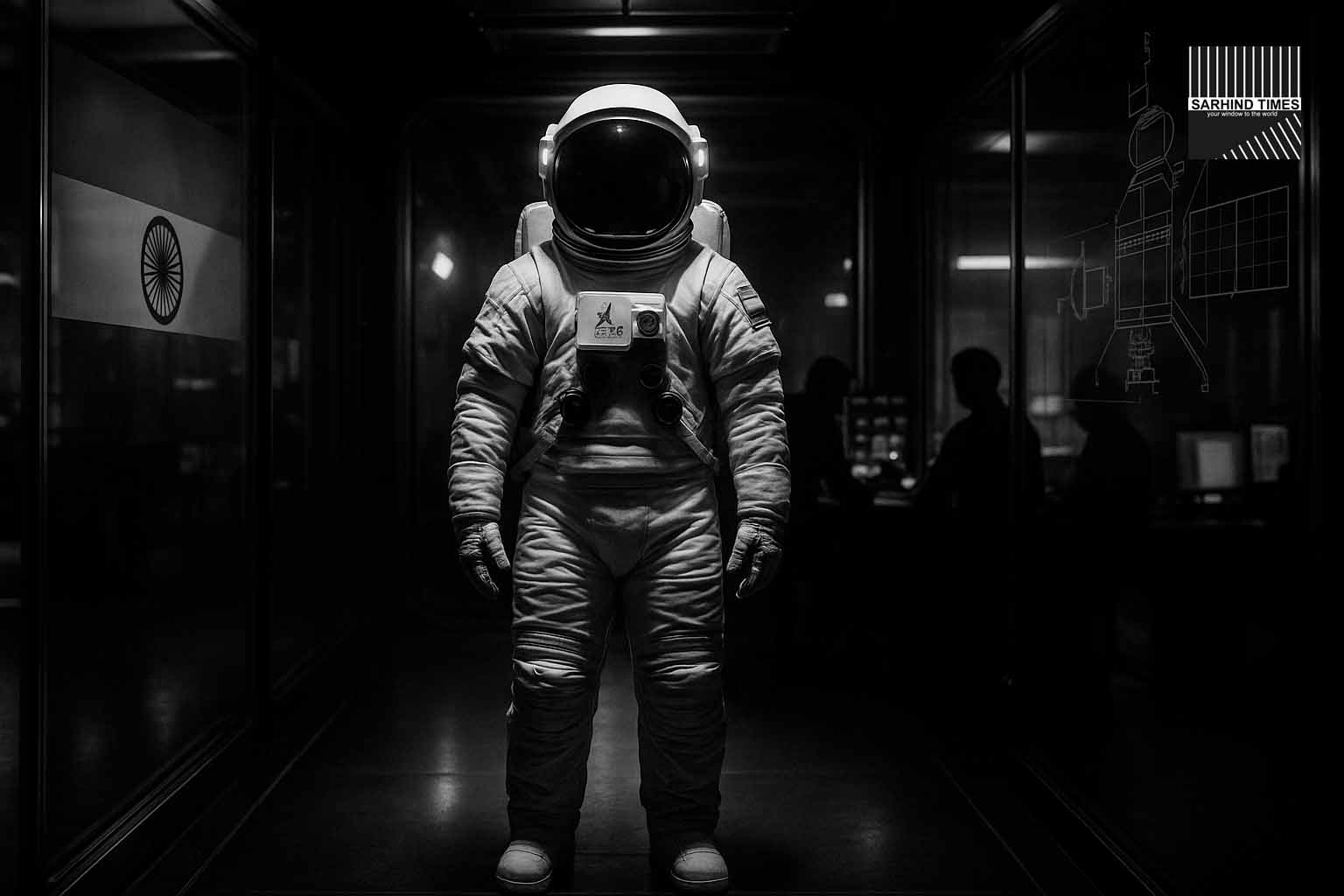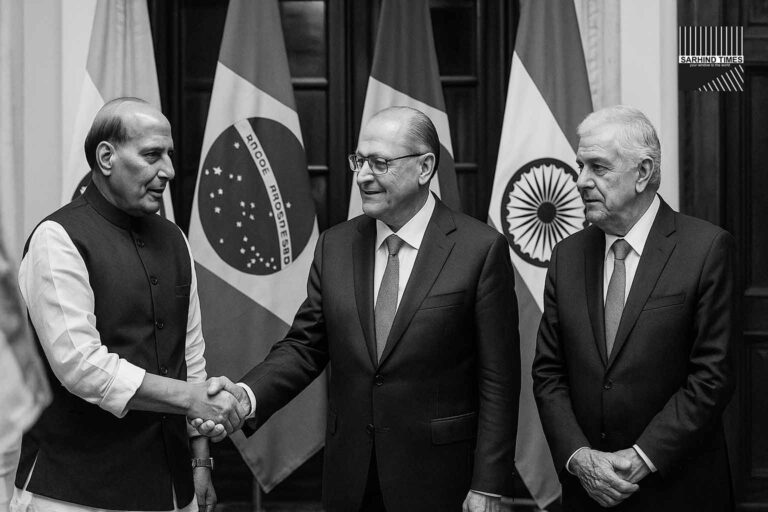India outlines its long-term human spaceflight roadmap as global partnerships, innovation, and national pride converge.
(By Sarhind Times Science & Policy Bureau | Bengaluru | October 17, 2025)
Bengaluru — India’s Cosmic Blueprint Expands
India’s journey from launch pads to lunar plains took a definitive step forward this week as ISRO Chairman V. Narayanan confirmed timelines for two historic goals — the Gaganyaan human spaceflight mission in 2027 and a crewed lunar landing by 2040.
The announcements, made during a review meeting at the U.R. Rao Satellite Centre, underscore India’s determination to transition from a launch service powerhouse to a comprehensive human space exploration nation.
“Gaganyaan is on track for 2027. The goal of putting Indians on the Moon by 2040 will require persistence, partnerships, and precision,” said Dr. Narayanan, addressing media and scientists.
With these declarations, India formally joins an elite club of nations — the United States, Russia, and China — pursuing sustained human presence in space.
From Chandrayaan to Gaganyaan: A Continuum of Confidence
The announcements come on the heels of India’s lunar triumph with Chandrayaan-3, which achieved the first-ever soft landing on the Moon’s south pole in August 2023.
That success established ISRO as a global symbol of low-cost innovation and mission reliability — a platform now extended toward human spaceflight.
The Gaganyaan mission marks India’s first attempt to send humans into low-Earth orbit (LEO) aboard an indigenous spacecraft, a project combining the ingenuity of PSLV, GSLV Mk-III (LVM3), and next-generation technologies developed in-house.
“We are not just launching astronauts; we are launching India’s next industrial and scientific revolution,” said Dr. P.S. Nair, former ISRO scientist and one of the Gaganyaan advisors.
Gaganyaan 2027: Countdown to Human Spaceflight
Mission Overview
| Parameter | Details |
| Objective | India’s first crewed orbital flight |
| Timeline | Target launch: 2027 |
| Crew | 3 Indian astronauts |
| Orbit | ~400 km circular orbit around Earth |
| Mission Duration | 3 days |
| Launch Vehicle | LVM3 (Human-rated) |
| Crew Module | Pressurized, with life-support systems |
| Recovery | Indian Navy-led splashdown operation |
ISRO has already conducted multiple test flights, including:
- TV-D1 Abort Demonstration (2023) – validated emergency crew escape systems.
- TV-D2 (2024) – verified re-entry stability and parachute systems.
- Uncrewed Orbital Simulation (2025) – final precursor to human mission.
“Each test has reduced risk margins and built engineering confidence,” explained Dr. Umamaheswaran, Director, Human Spaceflight Centre. “We are at the stage where human-rating certification begins.”
The Human Factor: Astronaut Training and Crew Readiness
Four Indian Air Force test pilots, shortlisted for the Gaganyaan crew, have completed training modules in Bengaluru, Russia, and France, covering:
- Zero-gravity adaptation
- Life-support system management
- Emergency procedures
- Communication protocols
Training at the Astronaut Training Centre in Bengaluru (ATC-B) — India’s first — is now entering its advanced phase, focusing on mission simulation and endurance under variable gravity.
“Our astronauts are India’s ambassadors of science and courage,” said Dr. Narayanan. “They represent the human spirit that defines exploration.”
Moon Mission 2040: The Long Horizon
While Gaganyaan cements India’s entry into human spaceflight, the 2040 crewed Moon mission marks the country’s most ambitious scientific frontier yet.
The project envisions:
- Heavy-lift launch vehicles (successors to LVM3) capable of multi-ton payloads.
- Modular space habitats and docking systems.
- Surface mobility units (rovers and landers for human traversal).
- International partnerships for navigation, safety, and deep-space logistics.
“A 2040 lunar target is realistic if investment and political continuity persist,” said Rajeswari Pillai Rajagopalan, Director, ORF Space Policy Programme. “It will catalyze India’s aerospace supply chain and education ecosystem.”
Strategic Goals: Beyond the Moon
ISRO’s extended roadmap, approved by the Cabinet Committee on Economic Affairs, also includes:
- A Bharatiya Space Station (BSS) by 2035 for microgravity research.
- Development of Reusable Launch Vehicles (RLV) to reduce costs.
- Advanced propulsion technologies, including cryogenic and semi-cryogenic stages.
- Planetary exploration missions, including Venus and Mars follow-ups.
“The goal is continuity — to make human spaceflight a sustainable program, not a one-off spectacle,” said ISRO Mission Director Dr. Anil Joshi.
The Global Context: Race for the Next Space Age
India’s declaration arrives amid a renewed global race for lunar dominance:
- NASA’s Artemis Program plans to return humans to the Moon by 2026.
- China’s CNSA targets its crewed lunar mission around 2030.
- Japan and the UAE have announced robotic lunar partnerships.
India’s participation is both symbolic and strategic — asserting technological self-reliance while deepening international scientific cooperation.
“Space is no longer just exploration; it’s geopolitics, commerce, and culture,” said Ambassador Ajay Kumar, former ISRO representative to the UN COPUOS.
Technological Innovations: The Backbone of Success
The Gaganyaan program has fostered dozens of indigenous spin-offs across India’s aerospace and electronics sectors:
- Crew escape systems developed by Vikram Sarabhai Space Centre (VSSC).
- Life-support modules by HAL and DRDO’s Bioengineering Division.
- Heat shields and re-entry control systems by ISRO’s Trivandrum unit.
- Simulation software for real-time telemetry and navigation by startups.
Private firms — including Agnikul Cosmos, Skyroot, and Bellatrix Aerospace — are contributing modular subsystems and ground communication interfaces.
“Gaganyaan has democratized Indian space technology,” said Lt. Gen. (Retd.) Anil Ahuja, Space Industry Council. “It’s not just ISRO’s mission; it’s India’s.”
Economic Multiplier: Space as an Industry Catalyst
The human spaceflight program is projected to generate over ₹40,000 crore in direct and indirect economic value by 2030, through:
- High-tech manufacturing contracts.
- STEM skill development.
- Private sector R&D acceleration.
- Employment generation in specialized domains.
India’s space economy, currently valued at $10 billion, is expected to quadruple by 2040, making it one of the fastest-growing sectors globally.
“India’s space dreams are not just about glory; they’re about growth,” said Finance Secretary T.V. Somanathan during a policy roundtable.
Education & Inspiration: Igniting the Next Generation
Educationists and youth organizations hailed the announcement as a “new Chandrayaan moment” for India’s students.
“When children see their nation reaching for the stars, they dream differently,” said Dr. Kasturi Rangan, former ISRO Chairman.
Universities across India — including IITs, IISc, and NITs — are aligning research programs with ISRO’s human spaceflight goals, focusing on robotics, materials science, AI-based navigation, and aerodynamics.
The government’s “STEM for Space” initiative, set to launch in 2026, will integrate space science modules into the national education framework from middle school onwards.
India’s Soft Power in Space
Beyond technology, ISRO’s human space mission represents India’s cultural diplomacy — blending scientific excellence with peaceful exploration.
“We aim to be partners, not competitors,” Dr. Narayanan said. “Our missions will always carry a message of collaboration.”
Already, ISRO has invited participation from friendly nations for payload experiments aboard future Gaganyaan flights, signaling India’s emergence as a trusted global space collaborator.
Challenges Ahead
Despite the optimism, experts highlight formidable challenges:
- Ensuring human-rating certification for all mission systems.
- Building radiation-shielded cabins for long-duration lunar transit.
- Developing indigenous cryogenic upper stages for heavy-lift missions.
- Maintaining budget discipline amid ambitious targets.
“Spaceflight has zero tolerance for error,” cautioned Dr. Tessy Thomas, Director General (Aeronautical Systems). “We must build redundancy, reliability, and resilience.”
Public Sentiment and Pride
Across social media and scientific circles, the response was euphoric.
From school students drawing astronauts to engineers discussing propulsion stages, India’s digital conversation turned cosmic.
“We are the generation that saw Chandrayaan land. We will see humans from India fly,” tweeted one user, capturing the national mood.
The announcement also resonated across the diaspora, where Indian-origin scientists work at NASA, ESA, and private aerospace firms, many of whom hailed India’s entry into the human spaceflight era.
The Political Dimension: Continuity and Vision
Prime Minister Narendra Modi has personally championed India’s space vision, aligning it with “Viksit Bharat 2047” — India’s centennial independence goal.
“India’s tricolor will soon fly in space, carried by our own sons and daughters,” the PM had declared during the 2023 Independence Day address.
The continuity of funding, institutional autonomy, and international collaboration will be crucial for sustaining the multi-decade lunar roadmap.
ISRO’s Upcoming Mission Calendar
| Year | Mission | Objective |
| 2026 | Uncrewed Gaganyaan Simulation | Final flight rehearsal |
| 2027 | Gaganyaan Human Spaceflight | First crewed Indian mission |
| 2030–2035 | Bharatiya Space Station (Phase I) | Microgravity research |
| 2035–2038 | Deep Space Habitat Module | Lunar mission preparation |
| 2040 | Crewed Moon Landing | Indian astronauts on lunar surface |
Conclusion: A Nation Looks to the Stars
India’s space story has always been about ambition meeting accessibility — from Aryabhata (1975) to Chandrayaan (2023) and now Gaganyaan (2027).
The latest roadmap is more than a schedule of launches; it’s a manifesto of national self-belief — proof that a developing nation can dream, design, and deliver at the edge of possibility.
As countdowns begin for the first human-rated launch, India’s space age stands on the brink of history once again — its gaze fixed firmly on the stars, and its feet grounded in science.
“We have mastered the sky,” Dr. Narayanan said, smiling. “Now, we walk toward the Moon.”
#ISRO #Gaganyaan #MoonMission #SpaceTech #IndiaInSpace #Innovation #STEM #Exploration #ScienceAndTechnology #PrideOfIndia






















+ There are no comments
Add yours